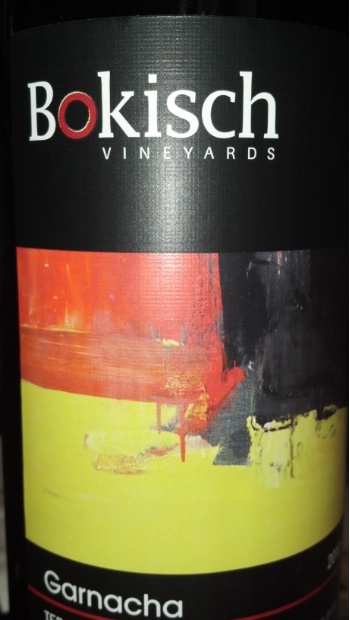
External search
Google (images)
Wine Advocate
Wine Spectator
Burghound
Wine-Searcher
Vintages
2020
2019
2018
2017
2016
2015
2014
2013
2012
2011
2010
2009
2008
From this producer
Show all wines
All tasting notes
|
| Drinking Windows and Values |
| Drinking window: Drink between 2012 and 2015 (based on 7 user opinions) |
| Community Tasting History |
| By Richard Jennings
RJonWine.com (10/8/2011)
(Bokisch Vineyards Garnacha Terra Alta Vineyard) Medium red color with 2 millimeter clear meniscus; tart cherry, strawberry nose; tart cherry, strawberry palate; medium-plus finish 87 points |
NOTE: Scores and reviews are the property of RJonWine.com. (manage subscription channels) |
| Bokisch Vineyards Producer websiteGarnachaWikipedia: In Spain, Grenache is known as Garnacha and given the likely history of the grape this is most likely the grape's original name. There are several clonal varieties of Garnacha with the thin-skinned, dark colored Garnacha Tinta (sometimes spelled Tinto) being the most common. Another variety, known as Garnacha Peluda or "Hairy Grenache" due to the soft softly hairy texture on the underside of the vine's leaves is also found in Spain, mostly in Borja and Cariñena (Aragón). Compared to its more widely planted cousin, it produces wines lower in alcohol and higher in acidity that show spicy and savory notes more readily as they age.[11] Widely planted in northeastern and central Spain, Garnacha was long considered a "workhorse" grape of low quality suitable for blending. In the late 20th century, the success of the Garnacha based wines from Priorat in Catalonia (as well as the emerging international attention given to the New World Rhone Rangers) sparked a re-evaluation of this "workhorse" variety. Today it is the third most widely planted red grape variety in Spain (behind Tempranillo and Bobal) with more than 203,300 acres (82,300 ha) and is seen in both varietal wines and blends.[3]
Garnacha plays a major role in the Denominación de Origen Calificada (DOC/DOQ) wines of Rioja and Priorat and the Denominación de Origen (DO) wines of Navarra and all southern Aragonese and southern Catalonian appellations, plus the mountainous areas just southwest of Madrid: Méntrida and Cebreros. In Rioja the grape is planted mostly in the warmer Rioja Baja region located in the eastern expanse of the wine region. Usually blended with Tempranillo, Garnacha provides juicy fruitiness and added body. In recent years, modern Rioja producers have been increasing the amount of Garnacha used in the blend in order to produce earlier maturing and more approachable Riojas in their youth. Garnacha is also used in the pale colored rosados of Rioja.[3] The vine has a long history in the Navarra region where it has been the dominant red grape variety with nearly 54% of the region's vineyard planted with Garnacha. Compared to neighboring Rioja, the Garnacha-based blends of Navarra are lighter and fruitier, meant for earlier consumption.[5]USAAmerican wine has been produced since the 1500s, with the first widespread production beginning in New Mexico in 1628. Today, wine production is undertaken in all fifty states, with California producing 84% of all U.S. wine. The continent of North America is home to several native species of grape, including Vitis labrusca, Vitis riparia, Vitis rotundifolia, and Vitis vulpina, but the wine-making industry is based almost entirely on the cultivation of the European Vitis vinifera, which was introduced by European settlers. With more than 1,100,000 acres (4,500 km2) under vine, the United States is the fourth-largest wine producing country in the world, after Italy, Spain, and France.California2021 vintage: "Unlike almost all other areas of the state, the Russian River Valley had higher than normal crops in 2021, which has made for a wine of greater generosity and fruit forwardness than some of its stablemates." - Morgan Twain-Peterson Central Valley The Central California Winegrowers (Official site) | Central Valley (California Wine Institute) |
|




